Bologna
It is very hard for me to show you my town in a few
words, I could talk about monuments, museums
and porticoes, but this page cannot substitute a good historical-art
guide, it's is only a list of suggestions to stimulate your curiosity.
Perhaps I will convince you to come to walk under the 35 kms of
porticoes of my city.
My lovely town has about 500,000 inhabitants,
it is located in the north of Italy (Emilia Romagna region) not far
from Florence and Venice, so you can include Bologna in your tour of
"MUST TO SEE" in Italy!
PIAZZA MAGGIORE
You surely have to start the visit of Bologna
from Piazza Maggiore the historical, administrative and human
heart of the city. It is the focal point of city life as here
there are some of the most important monuments and the Town Hall,
here the citizens use to meet during special events or exhibitions,
here every day you may find some child trying to learn walking
looking for pigeons on "crescentone" (the center of the square).
Piazza Maggiore is the mirror of the city: there are always people
chatting and ready to include you in theyr debates; there are
porticos and towers (the tower of Clock of Palazzo D'Accursio
and the tower of Arengo of Palazzo del Podestà) and other
splendid buildings to observe while you are seated on the steps
of S.Petronio.
In Piazza maggiore you find: the Basilica of San
Petronio, the Palazzo dei Notai, the Palazzo D'Accursio or Palazzo
Comunale -Town Hall- (which is the home of the Tourist Acceptance),
the prestigious Museo
Morandi and the Municipal Art Collections), the Palazzo del
Podestà, the Palazzo di Re Enzo and the Fontana del Nettuno
and the Palazzo dei Banchi.
 Perhaps,
most loved monument from Bologna inhabitants is the
Basilica of S.Petronio, the fifth church of the world,
dedicated to the Patron of the city, it is so beautiful even if
its incomplete facade. Perhaps,
most loved monument from Bologna inhabitants is the
Basilica of S.Petronio, the fifth church of the world,
dedicated to the Patron of the city, it is so beautiful even if
its incomplete facade.
To right, we find the Palace
of the Notai (Notary), with its splendid medieval windows
and merlature.
 In
front of the Basilica, you find the Palazzo
del Podestà, with its great hall(61 meters for
14) to the first floor. In
front of the Basilica, you find the Palazzo
del Podestà, with its great hall(61 meters for
14) to the first floor.
Palazzo D'Accursio
is the Town Hall. From the courtyard, to the second floor, you
arrive to Museo Morandi and the Municipal Art Collections, and
even if you decide not to visit them, it will worth the wonderful
view of the square from windows of the cafeteria.
 In front of Palazzo Re Enzo
there is the excellent fountain of Neptune (Fontana
del Nettuno) executed by Giambologna in 1564. The Palace
of Re Enzo was constructed in the 1244-46 as town hall and was
the place where Enzo King of Sardinia (son of the Ghibelline emperor
Federico II) was kept in prison for nearly 30 years (was the 1249).
In front of Palazzo Re Enzo
there is the excellent fountain of Neptune (Fontana
del Nettuno) executed by Giambologna in 1564. The Palace
of Re Enzo was constructed in the 1244-46 as town hall and was
the place where Enzo King of Sardinia (son of the Ghibelline emperor
Federico II) was kept in prison for nearly 30 years (was the 1249).
Now I hope you are wearing your favourite and most
confortable pair of shoes, as you have to say good bye to the
Giant (the way Bolognesi use to call Neptune because of its three
meters of height!) and start walking!
Alongside S.Petronio there is Palazzo
dei Banchi and the Pavaglione
Portico begins. It was built in 1565 and is one of the most famous
and loved among the Bolognesi, it connects the great square to
the Palazzo dell'Archiginnasio,
a sixtenth century palace , the first permanent seat of the University
of Bologna. be enchanted by the largest Italian municipal library
with more than 600.000 books and thousands of manuscripts and
sixtteenth century editions. Near to Archiginnazio, you will appreciate
the Archeological
Museum, which has one of the largest and most important
collections of Egyptian, Roman, Villanovian and Etrusca antiquities.
 Just behind the Pavaglione through any of its large arcades is
one of the most typical parts of the historical centre where is
a real pleasure to wonder around the stands of the food market
and the food shops.
Just behind the Pavaglione through any of its large arcades is
one of the most typical parts of the historical centre where is
a real pleasure to wonder around the stands of the food market
and the food shops.
In via Drapperie there is one of the most famous food shops, Tamburini,
that now has a small self service opened at lunch time. You have
to taste Mortadella and Parmigiano Reggiano cheese.
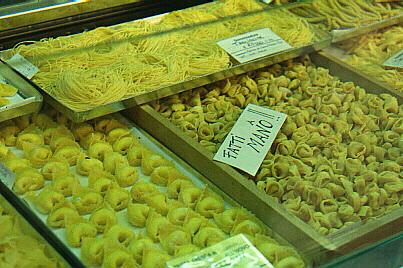 Little
beyond a great "baker", Atti, where to buy the optimal Bologna
bread, crescenta and the "pasta fresca" as the traditional tortellini
or tagliatelle. Little
beyond a great "baker", Atti, where to buy the optimal Bologna
bread, crescenta and the "pasta fresca" as the traditional tortellini
or tagliatelle.
Then you may stop in Via Orefici to the Bar Otello where people
spoke rigorously about sport, soccer and Bologna team. In Vicolo
Ranocchi there is a typical "wine cellar", Il Baretto, where only
wine is served... if you want to eat a sandwich... you have to
take it from home!!!
THE TWO TOWERS
The large via Rizzoli,
a relatively "modern" (end '800) street, connects Piazza Maggiore
to the second most loved place in town: Piazza
di Porta Ravegnana where you see the Two
Towers, symbol of the city.
 In
Middle-ages there were nearly 180 towers in Bologna, and even
now more than twenty, dotted around all the city centre, can still
be admired. Asinelli Tower
is the higher, is about 98 metres and was built between 1109 and
1119 by the family of the same name. The Garisenda
Tower is the lowest fo the two, it is 48 meters high
and was shorted during the XIV sec. to avoid any risk. In
Middle-ages there were nearly 180 towers in Bologna, and even
now more than twenty, dotted around all the city centre, can still
be admired. Asinelli Tower
is the higher, is about 98 metres and was built between 1109 and
1119 by the family of the same name. The Garisenda
Tower is the lowest fo the two, it is 48 meters high
and was shorted during the XIV sec. to avoid any risk.
If you do not fear to go up 498 steps, you will enjoy the view
from the top of Asinelli, (it costs only 3.000 Lire!)
From the Two Towers, from via de Giudei, you enter
the Jewish Ghetto where the
Church government confined the Jewish from 1556 to 1593. It has
been recently restored with the typical paving and nice iron lamps.
 In the opposite direction, from Two Towers, have a look toward
via Castiglione in order to admire Palazzo
della Mercanzia with its flowery gothic jowel, the
Loggia del Carrobbio.
In the opposite direction, from Two Towers, have a look toward
via Castiglione in order to admire Palazzo
della Mercanzia with its flowery gothic jowel, the
Loggia del Carrobbio.
Here, we note that some of the main city roads form a crossroad.
One of these in Via Santo Stefano, leading to the Piazza by the
same name. The architectonic complex, know as the Chiesa delle
Sette Chiese [Church of the Seven Churches] unfolds its monumental
romanesque style and the heady beauty of its columns in cipolin
marble.
But I suggest you to arrive to P.zza S. Stefano from Strada Maggiore,
a road that both historical and artistic, elegant and popular
at the same time...
PIAZZA S. STEFANO
When you arrive to Strada Maggiore, to number 19,
you find one of the most interesting Italian example of 13th century
wooden portico of Casa Isolani, it is called the one of the three
arrows. People say that a betrayed husband wanted to kill his
wife hiring three archers. But the woman suprised them by showing
herself without dresses, so the three men, mistook the sight embedding
the arrows into the ceiling. (but I've to see that I've never
been able to see them!)
From here, through the gallery of Corte
Isolani (Isolani Court) you arrive in the evocative
Piazza S.Stefano.
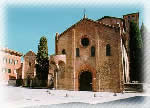 The Church of S. Stefano is
a complex made from more buildings of various ages. The Seven
Churches, (now they are only 4) are an interlace of churches,
courtyards, cloisters, chapels, crypts, which together look out
on to Piazza Santo Stefano. Remember to visit the tomb of S.
Petronio and the beautiful Romanesque cloister.
The Church of S. Stefano is
a complex made from more buildings of various ages. The Seven
Churches, (now they are only 4) are an interlace of churches,
courtyards, cloisters, chapels, crypts, which together look out
on to Piazza Santo Stefano. Remember to visit the tomb of S.
Petronio and the beautiful Romanesque cloister.
VIA D'AZEGLIO and VIA
CARBONESI
Via D'Azeglio
starts from Piazza Maggiore, and as it is completely pedestrian,
is considered the ideal for the shopping!
Near there, you will find Corte
de' Galluzzi is one of the few examples of protected
complex of tower and court. The Galluzzi family was one of most
turbulent during XII and XIII century, with diputes and conspiracies
they caused many risks for the city. I just want to tell you the
tragic history of Virginia Galluzzi and Alberto Carbonesi who
secretly married themselves. As Romeo and jliet families, Carbonesi
and Galluzzi were ennemy, so when they were discovered from the
father of her, he decided to kill the joung man and all its relatives
who had collaborated to the marriage. The pain for the poor Virginia
was too much, so she hung herself.
When you arrive to the bottom of via D'Azeglio,
turn right trough via Carbonesi.
Little beyond, you find Majani
stores where I suggest to stop if you love chocolate. Try the
most famous Fiat is the liberty style shop, which is nearly unchanged
from the opening in 1834 (but the company was founded in 1796)
From the next door you enter COIN, which hide a great treasure
(unfortunately they are closed -13/03/2004-).
Enter and you will discover that the store has been integrated
and constructed over to the rests of the
Roman Theatre, you will walk on the ancient paving!
VIA INDIPENDENZA
From Piazza Nettuno it
leaves the Via Indipendenza, great for shopping and
the tipycal walk fo saturday afternoon. Along this way the dome
of Bologna can be found: theCathedral
of S. Pietro who goes back to the 910 but has been
restored and modified many times. Even if this is the dome of
the town, it is not the loved church for Bolognesi as S.Pietro
has always been the symbol of the central power (Bologna was the
second city of the Church State) while S.Petronio was the Church
of the people.
Just in front S. Pietro you see the Hotel
Baglioni, the most prestigious hotel in Bologna with
its rooms painted from Carracci. Go on walking down the street,
and you will arrive to cross Via Augusto Righi. Go in Via
Malcontenti. Here you may discover that under Bologna
roads there are many water channels made in 1185.
On fridays and saturdays, in Piazza 8 agosto, there
is the most traditional rendez-vous: the market called "Piazzola"
which is held near the park of "Montagnola".
In the park you may find another market, it is the second-hand
clothing one.
Other:
S.FRANCESCO
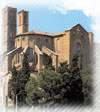 From Piazza Maggiore, opposite to Via Rizzoli, you can follow
Via Ugo Bassi in order to arrive to Piazza
S.Francesco with the magnificent Gothic S. Francesco
from 13th century. Nearby you will see the Tombe dei Glossatori
(Tombs of Glosstors), some pyramidal mausolei dedicated to the
first masters of the university in 1200.
From Piazza Maggiore, opposite to Via Rizzoli, you can follow
Via Ugo Bassi in order to arrive to Piazza
S.Francesco with the magnificent Gothic S. Francesco
from 13th century. Nearby you will see the Tombe dei Glossatori
(Tombs of Glosstors), some pyramidal mausolei dedicated to the
first masters of the university in 1200.
SAN DOMENICO
 In
Piazza S.Domenico, you will be able to admire the
Basilica of S. Domenico, built in the 13th century,
there are great paintings and the famous "Arca
di S.Domenico" sculptured amongst others by Nicoḷ
da bari (known as Nicoḷ Dell'Arca after this work) and by Michelangelo.
Annexed to the church are other Tombe dei Glossatori (Tombs of
Glosstors). In
Piazza S.Domenico, you will be able to admire the
Basilica of S. Domenico, built in the 13th century,
there are great paintings and the famous "Arca
di S.Domenico" sculptured amongst others by Nicoḷ
da bari (known as Nicoḷ Dell'Arca after this work) and by Michelangelo.
Annexed to the church are other Tombe dei Glossatori (Tombs of
Glosstors).
SAN LUCA
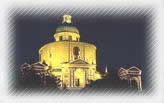  One of the most important portico is no doubt that of S.Luca,
it is longest in the world and links the city to the Sanctuary
of Madonna di S.Luca, stretching for three and half
kilometres (666 archades) over the hill of Monte della Guardia
(m. 298)
One of the most important portico is no doubt that of S.Luca,
it is longest in the world and links the city to the Sanctuary
of Madonna di S.Luca, stretching for three and half
kilometres (666 archades) over the hill of Monte della Guardia
(m. 298)
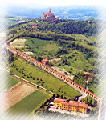 In
the Sanctuary there is a Madonna icon mad from the evangelista
Luca as people use to say. This is a very suggested site not only
for tourists, but also for Bologna inhabitants who use to climb
this porticos for faith, for fun and also for jogging. In
the Sanctuary there is a Madonna icon mad from the evangelista
Luca as people use to say. This is a very suggested site not only
for tourists, but also for Bologna inhabitants who use to climb
this porticos for faith, for fun and also for jogging.
By night both Basilica and portico are lightened in order to be
clearly visible from kilometres.
BOLOGNA AREA
The area of Bologna is so rich of villages, small
towns, monuments and parks to see. You may drive your car wondering
around to discover everything you want! I only want to talk to
you about the
south-west are, where I live.
| Your comments:
Christer writes to me: " I've just returned
home to Sweden after a lovely week in Bologna and northern
Italy. I want you to know that your information about Bologna
was very useful to me." |
The "One ticket for all the Museum" is available
with two different periods of validity. It provides admittance to Bologna's museums. You may also find
the "two-function ticket: to the museums by bus"; it is valid for
three days and provides admittance to Bologna's museums and the use of the whole
city network of the ATC public transport service.
Other usefull LINKS:
Iperbole
municipal WWW server
Discover Bologna by "Assessorato al turismo Comune di
Bologna"
Museum
in Bologna Area
A
guest of: Bologna monthly tourist edition bilingual magazine,
published by "Golden Keys Bologna"
Enjoy
life in the City-Centre by Centro Nuova Comunicazione
City
centre Map select one from "STRADE" (way) or a "POSTI"
(monuments, churches, palaces) and you will see where are on the
map!
Girabologna
virtual tout of the town
www.bolognadavivere.it
about Bologna nights
Al sît
bulgnais "il sito Bolognese" to know the local language
Tamburini
a well known gastronomy shop placed in the heart of the historical
centre
Italian
for travellers and some suggestions about Bologna
|